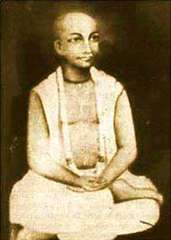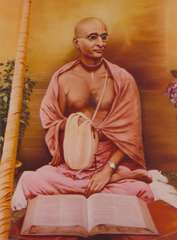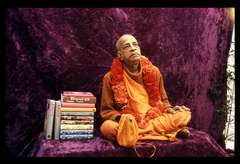All glories to Srila A.C. Prabhupada, Bhakti Svarupa Sripad Maharaja and Goura Bhakta Vrinda.
Hare Krsna,
HpS Guru Maharaja! Dandavat Pranam.
Please accept my humble obeisanses unto the Padmacharan of Guruji Maharja that the following is the comments of Prabhu Partha Sarathi Das on Manipuri Goudiya system of Shakhi-Manijari forwarded today.
“All Glories to Sri Guru and Sri Gouranga,
H. H. Respected Swamijee,
Please accept my humble pranam, Sriman Yamunesvara Prabhu has shown to me the comment of Sriman Haridas Gosvami on the Guru-Param-Para of the Manipuri Vaisnavism, which seems to be quite remote from the subject under discussion. I have nothing to comment on the remarks given by a sannyasi on his own accord. However, as I belong to the old traditional devout Manipuri Vaisnava family, I feel it obliged to say a few words he has not mentioned at all in his remarks, for the pleasure of my Spiritual Master and other vaisnavas.
To my mind, instead of giving his personal observation on the Guru-Param-Para of Manipuri Vaisnavism, it would have been more appropriate for him to have focused on the principles of Manipuri Vaisnavism as enunciated in the scriptures, which have been followed by each and every vaisnava under the strict supervision of their respective Spiritual Masters coming down through disciplic succession right from the days of Rajarsi Bhagyachandra (1776) till this day. Their presiding deity is Lord Sri Govinda currently being enshrined (worshiped) in the Mani Mandir of the palace of Manipur, Imphal.
Though I have very little knowledge about his background of Manipur Vaisnavism, I regard Sriman Haaridas Goswami as a simple and humble sannyasi. So far as I know, he is a Manipuri devotee born in Assam and brought up there. I never expect such a remark on Guru-Param-Para of Manipuri Vaisnavism, which may hurt the sentiment of Srila Prabhupada and Sri B.S. Damodara Swami, who were the great exponents of Manipuri Vaisnavism. Srila Prabhupada spoke highly of the Manipuri Vaisnavism and commented that Manipur was a great Vaisnava Kingdom and its vaisnava culture needs to be revived for the welfare of the humanity, as revealed in the purport of the Bhgagavatam (9.22.32). In view of this, the remarks on the Guru-Param-Para of Manipuri Vaisnavism is quite irrelevant and uncalled for, from a sannyasi like him who belongs in the ISKCON family, which is to be treated as a great aparadha (sin) to his Spiritual Master, B.S. Damodara Swami as well as Srila Prabhupada. However, may all the merciful Lord Sri Govinda always protect him for his innocence and ignorance.
As desired, for information of Swamijee, I am sending details of the Spiritual Masters coming down through disciplic succession, they are - Lord Sri Krishna - Sri Krishna Caitanya – Sri Gadhadhara Pandit – Sri Loka Natha Swami – Sri Narottama Das Thakur – Sri Ganganarayan Chakravarti – Sri Nidhirama Chakravarti – Sri Kunjabihari Das – Sri Ram Gopal Vairagi – Sri Rupa Pramananda Goswami – Sri Rajarsi Bhagyachandara – and his successive disciple so on and so forth, which are in the records of the history of Manipuri Vaisnavism and its Guruparampara, compiled by great Manipuri writer Late Sri Koijam Brajabihari Singh of Thangmeiband.
One special and unique feature of the Manipuri Vaisnavism, as distinct from others, is that, our approach is indirectly direct, that is, no vaisnava devotee of Manipur is allowed to approach Lord Sri Krishna, direct but through His consort, all merciful Radharani. Radharani is non-different from Krishna. Krishna is the origin of Radharani. Because of this, another name of Radharani is known as Krishna Swarupini. Radharani is the origin of all the Lakshmis including 16,108 Maharanis of Dwarika and Gopis of Vrindavana. So Radharani is known as the Swarva Laksmi Mayi Angsini. As such Gopies are non different from Radharani. Therefore, under the Manipuri Vaisnavism, vaisnaava devotees are allowed to approach Krishna through Radharani, Radharani through Sakhis, Sakhis through Manjari. Shakhis and Manjaris are all Gopis. Under the Manipuri Vaisnavism, at the time of initiation of one devotee, the Spiritual Master should explain the significant of the Spiritual Master and necessity for approaching Krishna through one of the Shakhi or Manjari. And accordingly, the Spiritual Master, on the day of the initiation of a devotee, he should give the name of the Sakhi or Manjari along with his initiated name, through whom he should chant Hare Krishna Mahamantra on the japas at least 5 rounds of chanting, three times a day (tri-sandhya) in the morning, in the noon, and in the evening, without fail. Under this strict system of Manipuri Vaisnavism, I was given initiation by my Spiritual Master (Purohit) of my clan in the late forties when I was thirteen years old. I was also made known the name of the Sakhi through whom I pray to and worship Lord Sri Krishna, along with my initiated name. All these should be kept strictly confidential.
One more important thing to be noted about Rajarsi Bhagyachandra is that he is illiterate; he can neither read nor write. But with the blessings of Lord Sri Govinda, he is endowed with the gifted in-born talent of intelligence and memory, like Maharisi Veda Vyas, son of Parasara Muni. Vyasdeva could learn all the Vedas from his father Parasara only by hearing once for all. Once he hears, it never goes out of his memory. Likewise, though illiterate, Rajarsi Bhagyachandra, whatever he hears from his Spiritual Master Rupa Paramanand Goswami, it never goes out of his memory. Rupa Paramand Goswami narrated all the contents of all the 90 chapters of the 10th Canto, with special emphasis on the Rasa Panchadhaya. King Bhagyachandra was fully motivated and specially attracted to the transcendental beauty of the Rasa Lila of the Gopis with Sri Krishna and could relish the nectarean divine rasa (taste) to his heart’s content. As a result of it, he could produce the world famous Maharas which was staged on the full moon night of the month of Kartika (Nov-Dec) 1779 and Nata-Sankirtana describing the nectarean pastimes of Sri Krishna in the Vraja-Vrindavan.
King Bhagyachandra choreographed the Maharasa, the great circular Rasadance (Raslila) of Lord Sri Krishna along with Gopies, based on the Rasa Panchadhyayas of Srimad Bhagavatam 10th Canto (from 29th to the 33rd Chapters) showing highest devotional touch ever shown by the Gopies to the lotus feet of Lord Sri Krishna. He further designed the newest form of classical Sankirtana (congregational chanting of the Harinama Mahamantra depicting the Vraja Kahani, the nectarean pastimes of Lord Krishna in Vrindavan, performed by a group of singers through their graceful body movement. This type of congregational chanting is known as Nata-Sankirtan. Nata means actors who depicts Vraja Kahani (pastimes of Lord Krishna in Vrindavana through their melodious voice and acting with gradual and graceful body movement.
This is the world famous devotional classical Sankirtana form available till this day in the world. Maharasa and the Nata Sankirtana are the two greatest contributions of Rajarsi Bhagyachandra in the Vaisnava Culture of Manipur.
I have made this letter a bit long unnecessarily which may give Swamiji a little trouble to read.
Hare Krishna,
To In the service of Lord Sri Krishna
Srila Hanumat Presaka Swami Maharaja Your fallen servant,
Partha Sarathi Das
-0-0-0-
Hanumatpresaka Swami,
Please accept my humble respects. You know that I love Manipur and Manipuri Vaisnava culture. You presentation was very concise and very nice. I have read some other books on the history of Manipuri culture, one was by a former Member of Parliament whom was a little famous. Maybe you know of whom I am talking.
I would have to know a lot more detail about the Parampara of Manipur to make any comments about the detailed practices. I did not see Haridas Swami's letter, so I do not know what his comments were.
Since ISKCON and Manipuri Vaisnavas, as you have so nicely described, are both in Parampara from Narottama Das Thakura then there should be points of agreement on his teachings in both of our traditions.
Specifically we are coming Param para from Srila Bhaktivinoda Thakura, Gaura kishora Das Babaji and Srila A. C. Bhaktivedanta tradition.
Of course, we also approach Krsna though Radha but also through Balarama in some cases. Then we also approach Radha through the Sakhis, specifically though Lalita whom we understand has incarnated in Gaura lila as Srila Svarupa Damodara, the personal secretary of Lord Caitanya. Lalita we approach though Rupa and Rati Manjaris et al, whom we understand to have incarnated in Gaura-lila as Rupa, Sanatana, Raghunatha Das Goswami et al.
So, in general Rupa Manjari can be accepted by someone such as Yamunesvara as their Manjari leader.
As established by Srila Bhakti siddhanta Sarasvati and then Srila Prabhupada, this internal connection and cultivation in Manjari Raga anuga is only something that is practically comprehensible when one on a liberated platform.
Adau sraddha, sadhu sanga, bhajana kriya, anartha nivritt, ruci... (BG As It Is 40.10 purport).
Of course, with second initiation in ISKCON we can consider that one is liberate to the level of Brahman realization ie. There IS a spiritual, eternal, all pervasive reality. Then with Sannyasa or Goswami initiation we expect that the devotee is realizing the deity in His paramatma feature, the Lord of the heart, present in everyone giving specific instruction.
So, in our Parampara we do not give Raganuga initiation until the student has come to this platform of Sannyasa. In the Nectar of Devotion Srila Prabhuapada specifically deprecates, following Srila Bhakti siddhanta Saravati the Siddha pranali initiation which makes this Manjari Raganuga Bhakti initiation while the student is in a very neophyte stage which can cause severe damage to their spiritual progress.
It is as you mention something confidential and Srila Prabhupada can give it being physically present or not. One has to be on the platform above bodily consideration, in complete accord with his Diksa guru and the Parampara.
Is this O.K.?
One does not have to take Sannyasa to be a Goswami. It is a meaningful formality but ladies, Grhasthas all can and eventually must come to the level of Goswamis informally before considering Raganuga Bhakti.
Rupa Goswami gives great details of all these things in Bhakti-rasamrta-sindhu and Srila Prabhupada gives us perfect access through Nectar of Devotion, and in turn all of the teachings of Narottama Das Thakura come through the BRS.
Nectar of Instruction, Upadesamrta, give an expert summary, and in turn some esteemed devotee such as ourselves of Yamunesvara Das can read even the first text and evaluate his level of development toward Brahman, Paramatma, Bhagavan, Krsna and Manjaris.
Is O.K? We can make practical progress! ? Hope to get to Manipur for Kartika next year.
Thank you so much. Is very, very satisfy to communicate with you. Hope we can do it eternally with the guidance of H. H. B. S. Damodara Swami.


